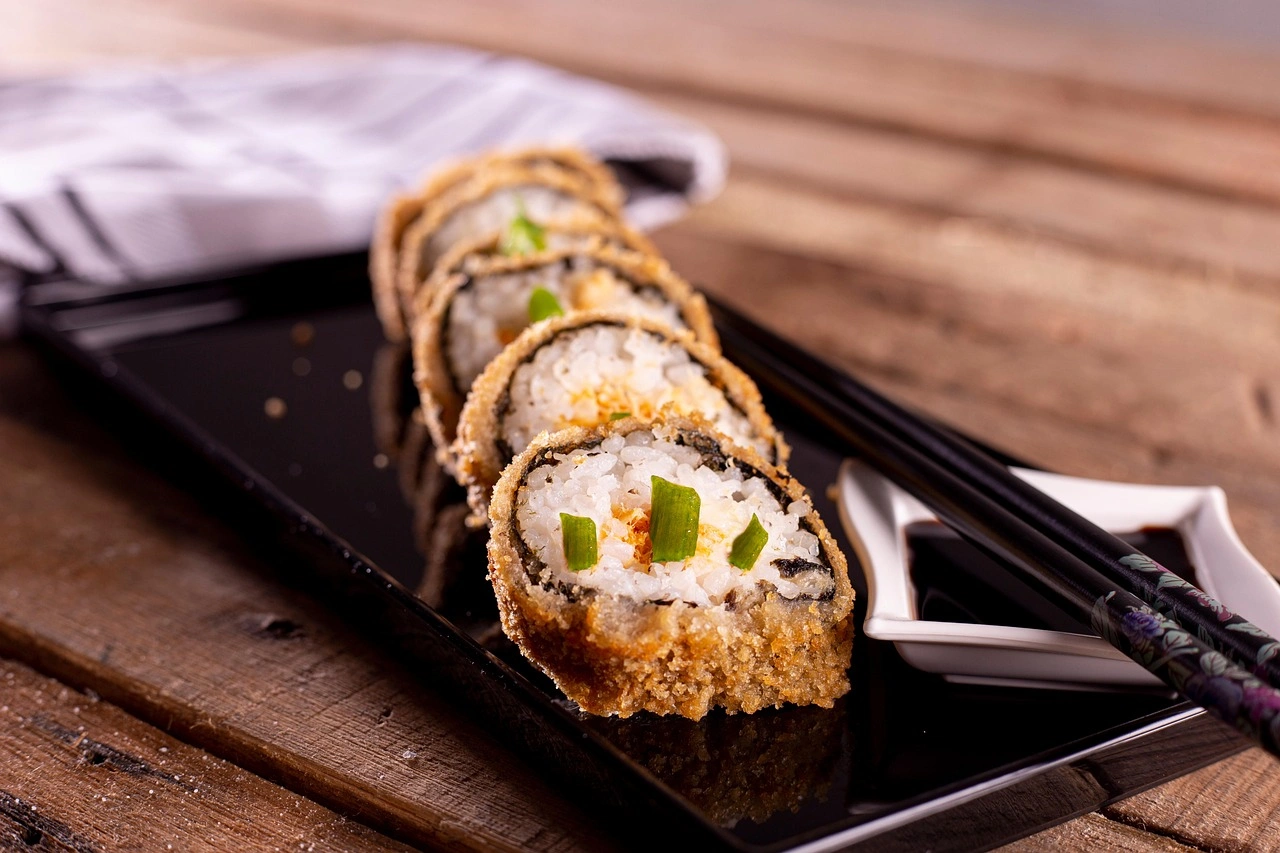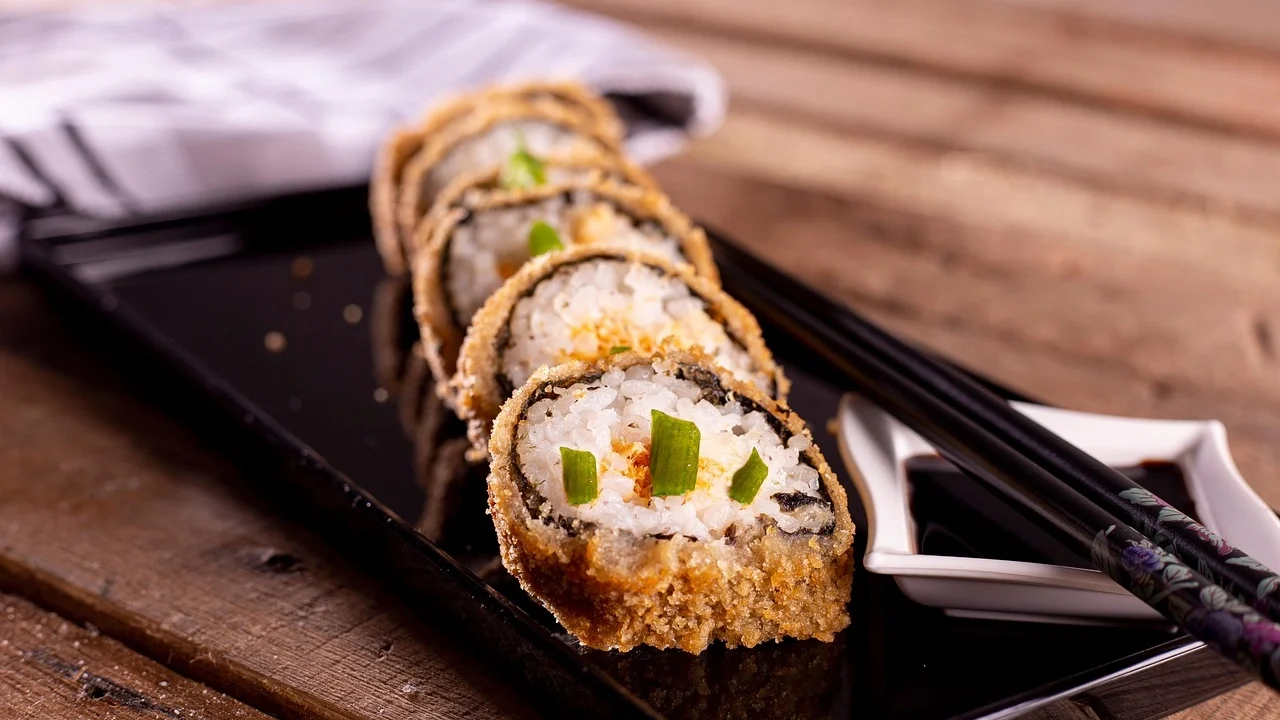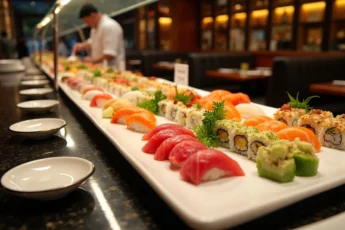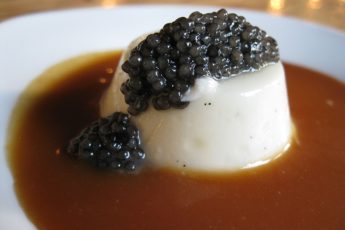Uni Sushi
Premium quality sea urchin can cost up to ¥10,000 per serving in Japan’s seafood markets. Sushi chefs worldwide just need this ingredient more than ever, though they can only use a handful of the thousand sea urchin species as food.
Japanese people eat about 80% of all sea urchins worldwide, showing their deep love for this delicacy. The term “uni” in Japanese cuisine specifically means the edible gonads of these spiny ocean creatures. Tokyo’s Toyosu market serves as the world’s biggest uni trading hub, where top-grade sea urchin sells for hundreds of dollars per kilogram. Japan controls 70% of the global uni market, and coldwater Ezobafun and Kitamurasaki make up three-quarters of Japan’s sea urchin harvest. Let’s explore uni sushi’s different types, unique flavors, serving techniques and sustainability challenges that affect this treasured Japanese delicacy.

What is Uni Sushi? Understanding the Basics
Japanese restaurants worldwide serve sea urchin as an orange or golden delicacy on rice. This luxury ingredient has earned a loyal following among sushi lovers who seek authentic Japanese dining experiences.
What is uni in Japanese cuisine?
Japanese cuisine calls “uni” (pronounced “oo-nee”) the edible gonads of sea urchins. These bright-colored lobes aren’t eggs or roe as many think, but reproductive organs that make either eggs or sperm based on the sea urchin’s sex. The world has about 950 sea urchin species, yet only 18 make it to our plates. Japan’s favorites are murasaki uni with its dark purple shell and sweet yellow insides, and bafun uni with its brown shell (nicknamed “horse poop uni”) that packs orange meat full of umami.
You’ll find five uni lobes inside each sea urchin, arranged like a star within its hollow spiny shell. These delicate treats have become one of Japanese cuisine’s most coveted ingredients, especially in upscale sushi spots.
Uni’s popularity as a sushi ingredient took off after World War II when chefs introduced gunkan-maki (battleship rolls) and better processing methods. Japanese diners now eat about 80% of the world’s sea urchins, showing just how much they value this special ingredient.
Why sea urchin gonads are used in sushi
Sea urchin gonads are a big deal in sushi for good reasons beyond their unique source. Fresh uni melts on your tongue with its creamy, custard-like texture. This velvety feel creates a unique contrast with sushi rice.
Uni’s taste is something special – rich and oceanic with sweet, briny, and umami notes in perfect harmony. Chef Jamel Jones calls it “sea butter” because of its rich taste that shifts from salty to sweet. These complex flavors work beautifully with subtle sushi rice.
Sea urchins only offer their gonads as edible parts. Getting them out takes skill and hard work, which adds to uni’s luxury status. These creatures need four to five years to grow large enough to eat, making them rare and expensive.
Difference between uni and fish roe
Uni and fish roe might look similar, but they’re quite different in what they are, where they come from, and how chefs use them. Fish roe comes from various fish species’ eggs, while uni is the actual reproductive organ that makes those eggs.
The texture sets them apart too. Uni feels creamy and custard-like, while fish roe pops in your mouth. Their flavors are different – uni brings complex ocean, sweet, and umami notes, while fish roe stays mostly briny.
Chefs use them differently too. Uni shines best as nigiri sushi (on rice), gunkan-maki (in seaweed “battleship” style), or as sashimi. Heat ruins uni’s luxury texture and subtle flavors, so it’s best enjoyed raw or barely touched.
Both male and female uni end up on our plates, each with its own charm. Male uni’s creamier texture comes with a fresh aftertaste and deeper yellow color. Female uni shows off orange to red shades and brings rich, sweet, mellow flavors.

Types of Uni Used in Sushi
Japanese chefs classify sea urchin into different varieties based on species, region, and color. Each type brings its own flavor profile that sushi connoisseurs value for different culinary uses.
Bafun Uni and Ezo-Bafun Uni
Bafun Uni (馬糞海胆), gets its name “horse dung sea urchin” from its looks. You’ll find it from Tohoku to Kyushu regions. This green-shelled variety is about 4cm wide with short, sharp spines. The gonads show a deep yellow color and pack a rich, umami-forward flavor despite their humble name.
Ezo-Bafun Uni (蝦夷馬糞海胆) is the premium Hokkaido version of Bafun. “Ezo” comes from Hokkaido’s historical name, that indicates its northern roots. This variety can cost up to ¥5,000 for 100 grams in peak season. Ezo-Bafun stands out from regular Bafun with its:
- More compact size with richer flavor
- Better shape retention during shipping
- Deeper orange coloration
- Spawning season from July to October
Chefs love using Ezo-Bafun’s creamy texture in nigiri sushi, gunkan-maki (battleship rolls), and uni donburi.
Kita-Murasaki Uni and Murasaki Uni
Murasaki Uni (紫海胆) is Japan’s most common sea urchin variety. The name “murasaki” means purple, describing its dark purple shell with thick, sharp spines. This everyday variety:
- Shows light yellow gonads
- Brings a refreshing, clean ocean flavor
- Sets the standard for uni taste
- Costs around ¥2,500 per box
- Spawns from May to August
Kita-Murasaki Uni (北紫海胆), the northern variant from Hokkaido, lifts the standard Murasaki experience. These sea urchins grow up to 10cm wide, making them larger than regular Murasaki. Japanese chefs consider Kita-Murasaki Japan’s finest uni, with plump lobes about the size of an adult thumb. Premium pieces can cost up to ¥10,000 per box and are known for their exceptional sweetness.
Aka Uni and Shiro Uni
Aka Uni (赤雲丹) is one of Japan’s hardest-to-find uni varieties. Its red-brown shell spans 5-8cm wide but only 2-3cm tall, giving it a flat look. Unlike other types, Aka Uni doesn’t have the bitter taste common in sea urchin. Instead, it offers:
- Delicate texture
- Light sweetness
- Good aftertaste
- Reddish-yellow gonads
- Spawning season from October to November
The lack of Aka Uni drives prices to about ¥10,000 for 50 grams in summer.
Japanese markets use “Shiro Uni” and “Aka Uni” as classification terms too. Shiro (white) means light yellow gonads usually from Murasaki-related varieties, while Aka (red) points to darker yellow gonads from Bafun-related species. Aka-classified uni tends to taste sweeter and last longer, which explains its higher price tag.
Imported varieties: Chilean, Canadian, and American uni
Chile runs the world’s largest sea urchin farms, making Chilean sea urchin (erizo rojo) the global production leader. The meat shows orange coloration with briny, fresh flavor and creamy texture. Chileans usually enjoy their uni raw with onion, lemon, and cilantro as an appetizer.
American uni comes mainly from California and Maine. Santa Barbara uni from California tastes exceptionally sweet compared to other regions. Maine’s specimens have a unique custard-like texture. Japanese markets know American Purple Sea Urchin as “Purple” and Northern Sea Urchin from Boston as “Green”.
Canadian uni tastes slightly saltier than Japanese varieties. Uni lovers point out that each region’s specimens reflect their local water conditions and diet, creating unique terroir expressions in every bite.
Taste, Texture, and Quality Factors
The magic of uni sushi goes beyond its looks to create an extraordinary sensory experience. Sushi chefs think about many factors when they select sea urchin gonads to prepare sushi.
What does uni sushi taste like?
The first bite of uni gives you a creamy texture that melts right on your tongue. This creates an exceptional mouthfeel with sushi rice. You’ll taste sweet and creamy notes mixed with a unique briny undertone. Good quality uni brings out distinct umami characteristics that go together with subtle ocean flavors. Fresh uni should never taste or smell “fishy” – that’s a sign of poor quality or bad handling.
The best uni feels like custard—firm yet giving slightly, just like flan. Its rich flavor builds slowly, starting with ocean notes before it reveals natural sweetness and a distinctive umami finish. This complex taste journey makes uni sushi popular among seafood lovers who want sophisticated flavors.
How diet and habitat affect flavor
Uni’s amazing taste variations come from environmental factors. Sea urchins eat mostly kelp. They use specialized mouthparts called Aristotle’s lantern to scrape and eat this seaweed. This diet helps create uni’s distinctive umami profile.
Water temperature, depth, and specific marine ecosystems shape the flavor. Cold-water uni from places like Hokkaido usually tastes sweeter than those from warmer waters. Farmed sea urchins often eat specially created kelp diets that improve their flavor.
Freshness and preservation methods
Freshness tells you everything about uni sushi quality. The best pieces show bright yellow-orange colors without dark streaks or spots that show spoilage. Good uni should feel firm yet plump, never watery or too soft.
Traditional processors use potassium aluminum sulfate (alum) to keep uni fresh and prevent shape changes. This treatment keeps uni good for 7-10 days but might affect its taste. Modern methods like nitrogen-enriched water processing stop oxidation and keep natural sweetness and texture for up to 28 days.
Why some uni tastes bitter
The bitter taste that sometimes shows up in uni comes from several sources. Alum treatments add metallic notes and astringency. That’s why high-end sushi places often ask for “additive-free” uni.
Natural bitterness can happen during spawning when the gonads have more bitter compounds. Uni that isn’t fresh enough changes chemically and starts to taste bad. Different regions and individual specimens taste different too, since genetics affect bitter taste receptors in both the uni and the person eating it.
How Uni is Served in Japanese Cuisine
Japanese sushi chefs serve uni with unique preparations that highlight sea urchin’s rich qualities through different textures and flavor combinations.
Nigiri vs Gunkan-maki vs Temaki
Uni nigiri shows the purest form—fresh sea urchin lobes sit atop vinegared rice with a thin nori strip. This simple style lets uni’s natural flavor shine. Gunkan-maki (battleship rolls) wraps uni in seaweed to create a vessel shape that keeps the creamy uni from falling off the rice. Chefs named it “battleship” because it looks like a small boat. They created this style specifically to hold loose ingredients like uni and different types of roe that wouldn’t work with regular nigiri.
Temaki (hand rolls) gives you a casual way to enjoy uni. These cone-shaped rolls combine rice and uni with extras like cucumber and shiso leaf in a nori wrapper.
Uni sashimi and donburi dishes
Uni sashimi lets you taste sea urchin at its finest—without rice. Hokkaido’s signature dish uni donburi features fresh uni on rice with a touch of wasabi and soy sauce. The luxurious uni-ikura donburi brings together sea urchin and salmon roe that create amazing texture contrasts.
Tokyo’s Tsukiji market serves maguro uni don, which combines sea urchin with fresh tuna sashimi and sometimes snow crab.
Pairings with other ingredients like ikura or ika
Japanese chefs create perfect matches for uni. Uni-ikura blends uni’s creamy sweetness with salmon roe’s salty bursts. Many restaurants serve hotate uni nosé where scallop’s gentle sweetness meets uni’s rich creaminess.
Ika (squid) and uni make another great pair. Ika-sashi no uni-ae gunkan brings squid sashimi and sea urchin together, while ma-ika no uni nosé puts sea urchin on Japanese flying squid. The chewy squid and smooth uni create an interesting contrast.
Traditional dishes like Ichigo-ni and Kaiyaki
Aomori Prefecture’s Ichigo-ni serves up a special clear soup with sea urchin and abalone. The name means “strawberry stew” because floating sea urchins look like wild strawberries. This dish started as fishermen’s food but became a holiday treat, especially on New Year’s Eve.
Northern coastal regions use scallop shells as natural cooking pots for kaiyaki miso. This rustic dish combines dashi broth, miso, green onions, and egg. Local fishermen would enjoy this flavorful meal between their catches.
Seasonality, Sourcing, and Sustainability
The quality and price of uni sushi changes with the seasons, which creates unique challenges and opportunities for both restaurants and their customers.
Best seasons for different uni types
Each type of uni has its own distinct harvesting season based on species and location. Wild sea urchin quality peaks from September through March in northern fisheries like Maine and British Columbia. Japanese uni varieties follow their own schedules: Hokkaido’s Bafun Uni tastes best from June to August, while Kita Murasaki Uni reaches its peak between January and June. The Tohoku region’s Murasaki Uni (Aomori, Iwate) hits prime condition from April to June. The Noto Peninsula’s Bafun Uni follows shortly after, reaching its best from June through September. The Aka Uni from Kyushu’s Iki and Goto islands shows its finest qualities from March to May.
Regions known for premium uni
Hokkaido leads Japan’s uni production, particularly with its sweet and creamy Bafun and Murasaki varieties. The region’s cold waters help sea urchins develop their vibrant yellow color and exceptional sweetness. Santa Barbara, California has earned worldwide recognition for its buttery, slightly briny uni that many top sushi chefs prefer. Maine’s Atlantic specimens offer bold ocean flavors with a firmer texture that appeals to people who enjoy intense taste profiles.
Sustainable aquaculture practices in Japan
Wild uni harvests continue to decline, pushing Japanese aquaculture to focus on environmentally responsible production. Land-based seaweed cultivation systems now provide controlled environments for sea urchins that help address warming ocean challenges. These state-of-the-art methods have become crucial since seaweed production—vital for healthy uni—dropped by about 70% over three decades, reaching around 60,000 tons by 2022.
Impact of overfishing and climate change
Japanese uni harvests have seen a dramatic decline—dropping from about 27,000 tons in 1970 to just 7,600 tons by 2018. Rising water temperatures limit kelp growth and reduce sea urchins’ food supply. These factors, combined with overfishing, create “urchin barrens” where sea urchins eat all remaining kelp, which makes the habitat quality worse. This environmental disruption affects wild stocks and leads to lower-quality uni, putting this delicacy’s future availability at risk.
Summing all up
Uni ranks among Japan’s greatest culinary gifts to the world. This prized delicacy earns respect through its distinctive texture and complex flavors. These delicate sea urchin gonads make an incredible journey from spiny ocean creatures to luxurious sushi delicacies. Bafun, Murasaki, and Aka uni give sushi lovers a range of experiences. Each variety brings its own taste characteristics that reflect their habitat and diet.
Fresh uni creates an unmatched sensory experience. Its creamy texture melts on your tongue as complex flavors unfold from briny beginnings to sweet, umami-rich finishes. Japanese diners consume about 80% of the world’s sea urchin harvest, though they make up just a small fraction of the global population.
Uni shines beyond simple nigiri presentations. Gunkan-maki, temaki, donburi bowls, and traditional dishes like Ichigo-ni show this ingredient’s amazing versatility in Japanese cuisine. Chefs around the world now use uni in their creations, yet many still rate Japanese varieties as the gold standard for quality and flavor.
Environmental concerns threaten this prized ingredient’s future. Climate change, overfishing, and dying kelp forests put natural uni populations at risk. This has led to new developments in aquaculture practices. These challenges remind us that protecting ocean ecosystems helps preserve both culinary traditions and marine life.
This delicacy opens up a world of adventure for newcomers to uni. Its distinctive taste might surprise you at first but often becomes addictive once you appreciate its subtle character. You can experience uni at high-end sushi counters or through regional Japanese specialties. Each bite offers a genuine taste of Japan’s rich culinary heritage and its deep bond with the sea.
Here are some FAQs about uni sushi:
What does “uni” mean in sushi?
In sushi terminology, uni refers to the edible part of a sea urchin’s reproductive organs, considered a delicacy in Japanese cuisine. When you see uni sushi on a menu, it typically features this bright orange or yellow sea urchin roe served atop rice. Many sushi uni enthusiasts seek out this unique ingredient at specialized uni sushi near me locations for its distinctive oceanic flavor.
What species is uni?
The uni used in sushi uni preparations primarily comes from several sea urchin species, most commonly the Japanese Muricidae family or California’s Strongylocentrotus purpuratus. Different uni sushi varieties offer subtle flavor variations, with premium versions coming from specific cold-water regions. High-end uni sushi and steak menu restaurants often highlight the origin of their sea urchin as a mark of quality.
Is uni healthy to eat?
Yes, uni is remarkably nutritious, packed with protein, omega-3 fatty acids, and essential minerals like zinc, making sushi uni a healthy indulgence. The sea urchin roe in what is uni sushi contains antioxidants and vitamins A, B12, and E. However, as with all seafood, moderation is key due to potential mercury content in some uni sushi near me offerings.
Is uni a sashimi?
While uni can be served as sashimi (without rice), it’s more commonly presented as nigiri in uni sushi preparations. What is uni sushi typically involves the sea urchin roe placed over vinegared rice, sometimes wrapped with nori. At upscale uni sushi and steak menu restaurants, you might find uni served both ways – as pure sashimi and traditional sushi.
Why do people like Uni sushi?
Sushi uni enthusiasts adore its unique creamy texture and complex briny-sweet flavor profile that’s often described as oceanic custard. The luxurious mouthfeel of uni sushi makes it a sought-after delicacy at high-end Japanese restaurants. Many uni sushi near me aficionados appreciate how premium uni delivers umami richness unlike any other seafood.
Is uni a superfood?
While not officially classified as a superfood, uni sushi certainly qualifies as a nutrient-dense food with impressive health benefits. The sea urchin roe in what is uni sushi contains high levels of beneficial fatty acids, proteins, and rare nutrients not found in many foods. Some uni sushi and steak menu restaurants promote uni’s nutritional profile alongside its gourmet appeal.




